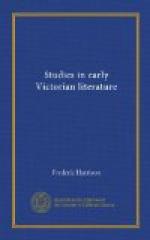This explains the paradox that the most popular, and most certainly the most praised of George Eliot’s works, are the simpler and the shorter. Every one enjoys the Scenes of Clerical Life, short stories of a hundred pages each, with simple plots and a few characters in everyday life. I have no doubt myself that Silas Marner comes nearer to being a great success than any of the more elaborate books. Yet Silas Marner is about one-fifth part of the length of Middlemarch; and its plot, mise-en-scene, and incidents are simplicity itself. There is no science, no book-learning, and but few ethical problems in it from beginning to end; and it all goes in one small volume, for the tale concerns but the neighbours of one quiet village. Yet the quaint and idyllic charm of the piece, the perfection of tone and keeping, the harmony of the landscape, the pure, deep humanity of it, all make it a true and exquisite work of high art.
Modern English (and I am one of those who hold that the best modern English is as good as any in our literature) has few pieces of description more gem-like in its crystalline facets than the opening chapter that tells of the pale, uncanny weaver of Raveloe in his stone cottage by the deserted pit. Some of us can remember such house weavers in such lonesome cottages on the Northern moors, and have heard the unfamiliar rattle of the loom in a half-ruinous homestead. How perfect is that vignette of Raveloe—“a village where many of the old echoes lingered, undrowned by new voices”—with its “strange lingering echoes of the old demon-worship among the grey-haired peasantry”! The entire picture of the village and its village life a hundred years ago, is finished with the musical and reserved note of poetry, such as we are taught to love in Wordsworth and Tennyson. And for quiet humour modern literature has few happier scenes than the fireside at the “Rainbow,” with Macey and Winthrop, the butcher and the farrier, over their pipes and their hot potations, and the quarrel about “seeing ghos’es,” about smelling them!
Within this most graceful and refined picture of rural life there is a dominant ethical motive which she herself describes as its aim, “to set in a strong light the remedial influences of pure, natural, human relations.” This aim is perfectly worked out: it is a right and healthy conception, not too subtle, not too common:—to put it in simpler words than hers, it is how a lonely, crabbed,




